Chapter 4
EVOLUTION
How do we know about ancient creatures?Scientists who study the extinct creatures that once roamed the Earth are called paleontologists. If you were to watch a paleontologist at work, you would probably see him on his hands and knees, methodically and painstakingly examining the surface of the ground. This is because he is looking for fossils, or else he has lost a contact lens.A fossil is any trace left behind by a living thing. Usually the term refers to mineralized bones, but it can also include teeth, eggs, footprints and unpaid phone bills. By careful analysis, paleontologists can often reconstruct an entire animal from just a tiny fragment of bone. (right) | 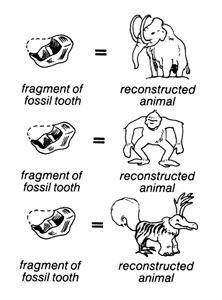 |
 |
By collecting and analyzing fossils, paleontologists have succeeded in tracing the
entire history of life on Earth, from the first living things to modern man. Of
course, there are gaps in the record and minor uncertainties of interpretation.
Nevertheless, the overall picture is clearly understood. (left)
How does evolution work?Animals of a given species are alike because they inherit a certain set of genes from their parents. Every so often, something goes wrong with the mechanism that transmits the genes, and an animal is born that doesn't resemble its father and mother. You probably know of examples in your own family.If this accidental variation, or mutation, is helpful in the animal's struggle to survive, it is more likely to be passed on to succeeding generations. In this way, new species can arise. |
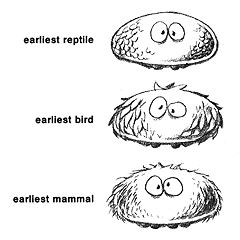 |
The First Living ThingsEvolution proceeds from simpler forms to the more complex. The first animals were simple one-celled blobs of protoplasm. Then two-celled animals arose. They were followed by three-celled, four-celled, five-celled, etc. (If you find the mathematics here too difficult, just think of the numbers larger than one as "many.")It is easy to see how this process led inevitably to more complex forms such as sponges, the worms and so forth. Especially if you don't think about it too much. |

Conquest of the Land - The Amphibians
The first vertebrates to exploit the rich food resources of dry land were the amphibians (from the Greek amphi-, slimy + bios, dumb). Many species attempted the transition without success. These early forms were hampered by their limited range and mobility on land.
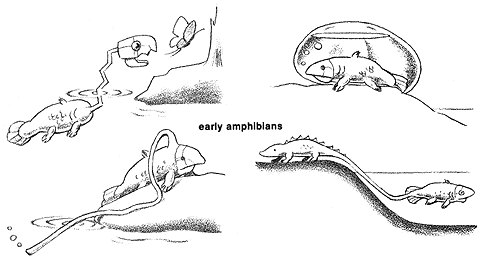
 |
A true land-dwelling form was made possible by the development of the lung. The amphibians, however, still had to return home to lay eggs and do their laundry. |
The Mammal-like Reptiles
This group, with characteristics that foreshadowed those of the later mammals, arose early in the development of the reptiles. However, other reptilian orders became the dominant terrestrial forms, crowding out these forward-looking species. As you may have noticed, often when you arise too early, you're no good for the rest of the day.

The Age of DinosaursThe reptiles reached their peak with the rise of the dinosaurs (from the Greek dino, ugly + sauros, smells bad).For millions of years, the Earth trembled under the footsteps of these giant reptiles, such as the fierce Tyrannosaurus Rex (right). This reconstruction reflects the current view that the dinosaurs , for all their size and ferocity, may have been closley related to birds. At the end of the Metatarsal Age, the dinosaurs abruptly vanished. The theory that a single catastrophic event may have been responsible has been strengthened by the recent discovery of a worlwide layer of whipped cream marking the Creosote-Tutelary boundary. |
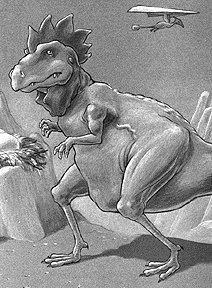 |
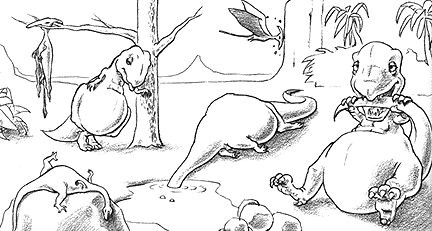
The dinosaurs have traditionally been pictured as slow, stupid and lethargic beasts (above). Recent thinking, however, suggests that they may in fact have been highly intelligent, active and well-adapted to their environment (below).
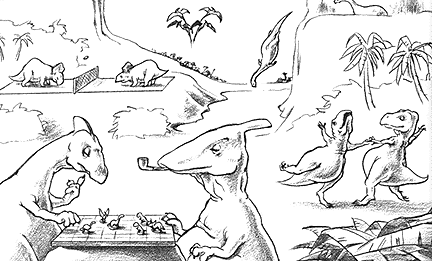
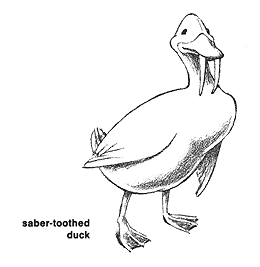 |
The BirdsAt the end of the Creosote era, two new classes arose to challenge the ruling reptiles - birds and mammals.The success of the birds was due in large part to their development of the feather. As you may recall from chapter 2, Galileo demonstrated that a feather falls more slowly than a lead weight. Being covered with feathers thus gave the birds a definite advantage over the flying reptiles, which were covered with lead weights. |
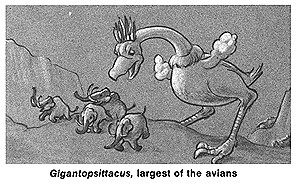 |
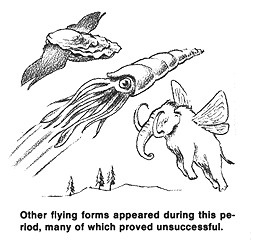 |
The Mammals
The first mammals were tiny shrewlike creatures. They seemed to be no match for the mighty dinosaurs. But though small, they were clever and may have contributed to the downfall of the giant reptiles.One of the mammals' evolutionary advantages was that they bore their young alive. As research has conclusively shown, animals that bore their young dead generally got nowhere.
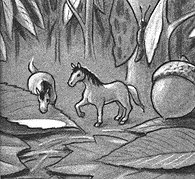 |

|
Early mammals were typically small, like the tiny Itsyhippus (left) and the Pond Hippopotamus (right).
The Rise of the Giant Mammals
After the Creosote extinctions, mammals were able to take advantage of the fact that they were endothermic (liked flowers), placental (had bad breath) and quadrupedal (didn't know any better) to spread and diversify.In the Tutelary Age, mammals became the dominant class and grew quite large at times. The great Irish bunny, for example, often had antlers eight feet across.
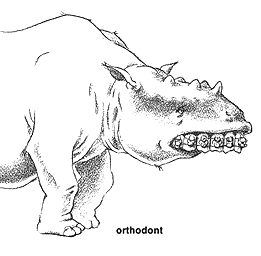 |
 |
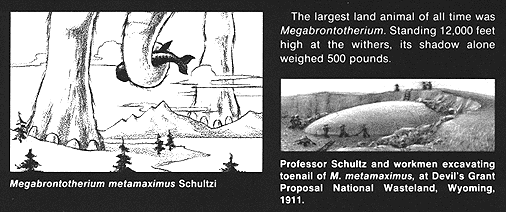
Introduction
The Universe /
Matter & Energy /
The Earth /
Evolution /
The Descent of Man